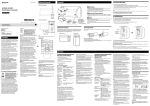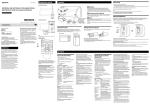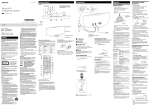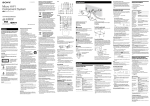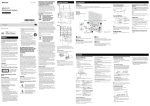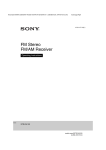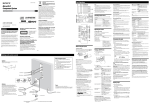Download Sony RDHGTK33iP User's Manual
Transcript
4-418-234-11 (1) Location of Controls Getting Started Setting the clock 1 Press to turn on the system. 2 Press TIMER MENU to select the clock set mode. Unit (Top) If “PLAY SET” flashes, press / repeatedly to select “CLOCK,” and then press Power HOME AUDIO DOCKING SYSTEM Operating Instructions Connect the power cord to a wall outlet. The demonstration appears on the display . When you press , the system turns on and the demonstration automatically ends. If the supplied adaptor on the plug does not fit your wall outlet, detach it from the plug (only for models equipped with an adaptor). 3 Press / repeatedly to set the hour, then press 4 Use the same procedure to set the minutes. Audio in L/R (DVD/PC IN jacks) Press DISPLAY . The clock is displayed for about 8 seconds. Connect an optional component such as digital audio players or a device with analog audio outputs, using a commercially available RCA audio input cable. Antennas To wall outlet AM loop antenna To DVD/PC IN L jack To DVD/PC IN R jack FM lead antenna (Extend it horizontally.) Unit (Front) ©2012 Sony Corporation Printed in China To reduce the risk of fire or electric shock, do not expose this apparatus to rain or moisture. To reduce the risk of fire, do not cover the ventilation opening of the apparatus with newspapers, tablecloths, curtains, etc. Do not place the naked flame sources such as lighted candles on the apparatus. To reduce the risk of fire or electric shock, do not expose this apparatus to dripping or splashing, and do not place objects filled with liquids, such as vases, on the apparatus. Do not install the appliance in a confined space, such as a bookcase or built-in cabinet. As the main plug is used to disconnect the unit from the mains, connect the unit to an easily accessible AC outlet. Should you notice an abnormality in the unit, disconnect the main plug from the AC outlet immediately. Do not expose batteries or apparatus with batteryinstalled to excessive heat such as sunshine, fire or the like. The unit is not disconnected from the mains as long as it is connected to the AC outlet, even if the unit itself has been turned off. Notice for the customers in the U.S.A. Owner’s Record The model and serial numbers are located on the rear of the unit. Record these numbers in the space provided below. Refer to them whenever you call upon your Sony dealer regarding this product. Model No. RDH-GTK33iP Serial No. 13)Unplug this apparatus during lightning storms or when unused for long periods of time. 14)Refer all servicing to qualified service personnel. Servicing is required when the apparatus has been damaged in any way, such as power-supply cord or plug is damaged, liquid has been spilled or objects have fallen into the apparatus, the apparatus has been exposed to rain or moisture, does not operate normally, or has been dropped. The following FCC statement applies only to the version of this model manufactured for sale in the U.S.A. Other versions may not comply with FCC technical regulations. The clock settings are reset when you disconnect the power cord or if a power failure occurs. To display the clock when the system is off Using the iPod/iPhone To prevent the iPod/iPhone from falling, always secure the iPod/iPhone with the holding arm when using the iPod/ iPhone with this system. When removing the iPod/iPhone, lift up the holding arm until it clicks and snaps into position, and then disconnect the iPod/iPhone from the iPod/iPhone connector. 1 Place the iPod/iPhone onto the iPod/iPhone connector. 2 Press the PUSH button until the holding arm is released with a click. The holding arm flips out to secure the iPod/iPhone. Rear Installing the system Using the remote The system can be installed either vertically or horizontally. Select the installation style based on your preferences (except for iPod nano model users). Note that with this system, horizontal installation is required when using iPod nano models. Insert the two R6 (size AA) batteries (supplied), matching the polarities shown below. This equipment has been tested and found to comply with the limits for a Class B digital device, pursuant to Part 15 of the FCC Rules. These limits are designed to provide reasonable protection against harmful interference in a residential installation. This equipment generates, uses and can radiate radio frequency energy and, if not installed and used in accordance with the instructions, may cause harmful interference to radio communications. However, there is no guarantee that interference will not occur in a particular installation. If this equipment does cause harmful interference to radio or television reception, which can be determined by turning the equipment off and on, the user is encouraged to try to correct the interference by one or more of the following measures: Reorient or relocate the receiving antenna. Increase the separation between the equipment and receiver. Connect the equipment into an outlet on a circuit different from that to which the receiver is connected. Consult the dealer or an experienced radio/TV technician for help. CAUTION You are cautioned that any changes or modifications not expressly approved in this manual could void your authority to operate this equipment. This symbol is intended to alert the user to the presence of uninsulated “dangerous voltage” within the product’s enclosure that may be of sufficient magnitude to constitute a risk of electric shock to persons. 1) 2) 3) 4) 5) 6) 7) This symbol is intended to alert the user to the presence of important operating and maintenance (servicing) instructions in the literature accompanying the appliance. License and Trademark Notice ® ® ® ® ® iPhone , iPod , iPod classic , iPod nano , and iPod touch are trademarks of Apple Inc., registered in the U.S. and other countries. MPEG Layer-3 audio coding technology and patents licensed from Fraunhofer IIS and Thomson. Windows Media is either a registered trademark or trademark of Microsoft Corporation in the United States and/or other countries. This product contains technology subject to certain intellectual property rights of Microsoft. Use or distribution of this technology outside of this product is prohibited without the appropriate license(s) from Microsoft. All other trademarks and registered trademarks are of their respective holders. In this manual, and marks are not specified. ™ ® PUSH button Holding arm Vertical installation Horizontal installation iPod/iPhone connector Note Headphone output is not available as this system does not have a headphone jack. Notes on using the remote With normal use, the batteries should last for about 6 months. Do not mix an old battery with a new one or mix different types of batteries. If you do not use the remote for a long period of time, remove the batteries to avoid damage from battery leakage and corrosion. Remote Note for iPod nano model users DO NOT install the system vertically when using iPod nano models with this system. iPod nano models cannot be secured with the holding arm because of their height. Install the system horizontally. Note on carrying the system DO NOT carry the system with the iPod/iPhone connected. If you do, the iPod/iPhone may fall and be damaged. Sony cannot accept responsibility for any damage caused by inappropriate usage. NOTE: Important Safety Instructions Read these instructions. Keep these instructions. Heed all warnings. Follow all instructions. Do not use this apparatus near water. Clean only with dry cloth. Do not block any ventilation openings. Install in accordance with the manufacturer’s instructions. 8) Do not install near any heat sources such as radiators, heat registers, stoves, or other apparatus (including amplifiers) that produce heat. 9) Do not defeat the safety purpose of the polarized or grounding-type plug. A polarized plug has two blades with one wider than the other. A grounding type plug has two blades and a third grounding prong. The wide blade or the third prong are provided for your safety. If the provided plug does not fit into your outlet, consult an electrician for replacement of the obsolete outlet. 10)Protect the power cord from being walked on or pinched particularly at plugs, convenience receptacles, and the point where they exit from the apparatus. 11)Only use attachments/accessories specified by the manufacturer. 12)Use only with the cart, stand, tripod, bracket, or table specified by the manufacturer, or sold with the apparatus. When a cart is used, use caution when moving the cart/apparatus combination to avoid injury from tip-over. Note GB RDH-GTK33iP WARNING When inserting the connector of FM lead/AM loop antenna, make sure to insert it in the correct orientation. Find a location and an orientation that provide good reception when you set up the antennas. Keep the antennas away from the power cord to avoid picking up noise. (enter) . . Notes When using commercially available iPod/iPhone cases, the connected iPod/iPhone may not be recognized by the system. If this happens, remove the case from the iPod/iPhone and reconnect it to the iPod/iPhone connector. When using a vertically installed system, make sure that the connected iPod/iPhone remains upright, not tilted. Operations Playing the iPod/iPhone 1 Select the iPod function. Press FUNCTION +/ repeatedly. This manual mainly explains operations using the remote, but the same operations can also be performed using the buttons on the unit having the same or similar names. To lock the buttons on the unit (Child lock function) You can lock the buttons except (on/standby) on the unit to prevent them from being operated by mistake. Hold down on the unit until “CHILD LOCK ON” or “CHILD LOCK OFF” appears on the display . The buttons except on the unit will be locked or unlocked. Note The child lock will be cancelled when you disconnect the power cord. Tip Operations using the buttons of the remote are possible even when the child lock function is enabled. 2 Place the iPod/iPhone onto the iPod/iPhone connector . 3 Press the PUSH button and secure the iPod/iPhone. 4 Start playback. Press . To control the iPod/iPhone To Pause playback Select a track or chapter of audiobook/ podcast Find a point in a track or chapter of audiobook/ podcast Choose the selected item Scroll up/down the iPod menus Return to the previous menu or select a menu Press (pause) / (stop) . (go back)/ (go forward) . To fast-forward or fast-rewind, hold down the button. Hold down (rewind)/ (fast forward) during playback, and release the button at the desired point. (enter) . / . TOOL MENU /RETURN (return) . To use the system as a battery charger You can use the system as a battery charger for an iPod/ iPhone whether the system is on or off. When charging the iPod/iPhone while the system is on, make sure to select a function other than the USB function. The charging begins when the iPod/iPhone is placed on the iPod/iPhone connector . The charging status appears on the iPod/iPhone display. When charging the iPod/iPhone, place the iPod/iPhone on the connector with the iPod/iPhone player stopped. For details, see the user’s guide of your iPod/iPhone. To stop charging an iPod/iPhone Remove the iPod/iPhone. Notes on charging an iPod/iPhone When the USB function is selected while the system is on, you cannot charge an iPod/iPhone. If the display mode is demonstration or clock, you cannot charge an iPod/iPhone even if the system is off. If you press DISPLAY while charging when the system is off, the system stops charging an iPod/iPhone. To restart charging of an iPod/iPhone, reconnect the iPod/iPhone when the display mode is Power Saving mode. Playing a file of the USB device Notes Check the websites below for the information about compatible USB devices. Turn the “Shake to Shuffle” function off on the iPod/iPhone to avoid unexpected track changes when listening to music at high volumes. If the battery of the iPod/iPhone is empty, the system may not recognize it. In such a case, recharge it with a computer, etc. then connect it to the system. The performance of the system may vary, depending on the specifications of your iPod/iPhone. When placing or removing the iPod/iPhone, handle the iPod/iPhone in the same angle as that of the iPod/iPhone connector on the unit and do not twist or sway the iPod/iPhone to prevent connector damage. Do not carry the unit with an iPod/iPhone set on the connector. Doing so may cause a malfunction. When placing or removing the iPod/iPhone, brace the unit with one hand and take care not to press the controls of the iPod/iPhone by mistake. Before disconnecting the iPod/iPhone, pause playback. Hold down / to fast-rewind (or fast-forward) while playing video if / does not function. To change the volume level, use VOLUME +/ . The volume level does not change if you adjust it on the iPod/iPhone. This system is designed for iPod/iPhone only. You cannot connect any other portable audio players to the iPod/iPhone connector. To use an iPod/iPhone, refer to the user’s guide of your iPod/iPhone. Sony cannot accept responsibility in the event that data recorded to iPod/iPhone is lost or damaged when using an iPod/iPhone with this system. The audio format that can be played back on this system is MP3/WMA*/AAC*. * Files with DRM (Digital Rights Management) copyright protection or files downloaded from an online music store cannot be played on this system. If you try to play one of these files, the system plays the next unprotected audio file. For customers in the U.S.A.: <http://www.esupport.sony.com/> For customers in Canada: English <http://www.sony.ca/ElectronicsSupport/> French <http://fr.sony.ca/ElectronicsSupport/> 1 Select the USB function. Press FUNCTION +/ repeatedly. 2 Connect the USB device to the 3 Start playback. (USB) port . Press . Other operations To Pause playback Stop playback Select a folder Select a file Find a point in a file Select Repeat Play Press (pause) . To resume play, press the button again. (stop) . To resume play, press (play) *1. To cancel resume play, press again*2. +/ repeatedly. (go back)/ (go forward) . Hold down (rewind)/ (fast forward) during playback, and release the button at the desired point. REPEAT repeatedly until “ ” (repeat all tracks) or “ ” (repeat one track) appears. *1When playing a VBR MP3/WMA file, the system may resume playback from a different point. *2Resume play returns to the top folder. To change the play mode Press PLAY MODE repeatedly. You can select Normal Play mode (playback in sequence of all files on the USB device), Folder Play mode (“FLDR” for all files in the specified folder on the USB device), or Shuffle Play mode (“SHUF”). Notes on the play mode When you select Shuffle Play mode “SHUF,” the system shuffle-plays all audio files on the connected USB device in random order. Shuffle Play mode may play the same file repeatedly. When the play mode is set to Folder Play mode, “ ” is not available. When the play mode is set to Shuffle Play mode, the repeat function is not available. When repeat play is set, Shuffle Play mode is not available. When repeat play is set to “ ,” Folder Play mode is not available. When you turn off the system, the selected Shuffle Play mode (“SHUF”) is cleared and the play mode returns to Normal Play mode. Note on Repeat play If you select “ ” when the system is in Normal Play mode, the system executes repeat play of all audio files on the USB device until you stop playback. If you select “ ” when the system is in Folder Play mode, the system executes repeat play of all audio files in the selected folder until you stop playback. Notes When USB cable connection is necessary, connect the USB cable supplied with the USB device. See the operation manual supplied with the USB device for details on the operation method. It may take about 10 seconds before “READING” appears depending on the type of USB device connected. Do not connect the system and the USB device through a USB hub. When the USB device is connected, the system reads all the files on the USB device. If there are many folders or files on the USB device, it may take a long time to finish reading the USB device. With some connected USB devices, after an operation is performed, there may be a delay before it is performed by this system. Compatibility with all encoding/writing software cannot be guaranteed. If audio files on the USB device were originally encoded with incompatible software, those files may produce noise or interrupted sound, or may not be played back at all. This system cannot play audio files on the USB device in the following cases; when the total number of audio files in a folder exceeds 100. when the total number of audio files on a USB device exceeds 10,000. when the total number of folders on a USB device exceeds 100 (including the “ROOT” folder and empty folders). These numbers may vary depending on the file and folder structure. Do not save other types of files or unnecessary folders on a USB device that has audio files. The system can play back to a depth of 8 folders only. This system does not necessarily support all the functions provided with a connected USB device. Resume play will be cancelled when you disconnect the power cord. Folders that have no audio files are skipped. The audio formats that you can listen to with this system are as follows: MP3: file extension “.mp3” WMA: file extension “.wma” AAC: file extension “.m4a” Note that even when file name has the correct file extension, if the actual file differs, the system may produce noise or may malfunction. To use the system as a battery charger You can use the system as a battery charger for USB devices that have a rechargeable function when the system is on. Press FUNCTION +/ repeatedly to select the USB function. The charging begins when the USB device is connected to the (USB) port . The charge status appears on the USB device display. For details, see the user’s guide of your USB device. Listening to the radio 1 Select the tuner (TUNER FM/TUNER AM) function. Press FUNCTION +/ repeatedly. 2 Perform tuning. For automatic scanning Press TUNING MODE repeatedly until “AUTO” appears, and then press +/ . Scanning stops automatically and “TUNED” and “ST” (for stereo programs only) light up on the display when a station is found. If “TUNED” does not light up and the scanning does not stop, press to stop scanning, then perform manual tuning (below). When you tune to an FM station that provides RDS services, information such as the service name or station name is provided by broadcasts. For manual tuning Press TUNING MODE repeatedly until “AUTO” and “PRESET” disappear, and then press +/ repeatedly to tune to the desired station. Tip To reduce static noise on a weak FM stereo station, press FM MODE repeatedly until “MONO” appears to turn off stereo reception. You will lose stereo effect, but reception will improve. Presetting radio stations 1 Tune to the desired station. 2 Press TUNER MEMORY to select the tuner memory mode. Using the timers The system offers 2 timer functions. If you use both timers, the Sleep Timer has priority. You can fall asleep to music. This function works even if the clock is not set. number. If another station is already assigned to the selected preset number, the station is replaced by the new station. 4 Press to store the station. 5 Repeat steps 1 through 4 to store other stations. You can preset up to 20 FM and 10 AM stations. 6 To call up a preset radio station, press TUNING MODE repeatedly until “PRESET” appears, and then press +/ repeatedly to select the desired preset number. Press SLEEP repeatedly to select the desired time. To cancel the Sleep Timer, press SLEEP repeatedly until “OFF” appears. Play Timer: You can wake up to FM/AM reception, iPod/iPhone or USB device at a preset time. Make sure you have set the clock. 1 Prepare the sound source. Prepare the sound source, and then press VOLUME +/ to adjust the volume. 2 Select the timer set mode. Press TIMER MENU . 3 Set the play timer. Press / repeatedly to select “PLAY SET,” then . press Using optional audio components 1 Prepare the sound source. Connect additional audio component to the DVD/PC IN L/R jacks on the unit using an audio analog cord (not supplied). 2 Adjust the volume level to minimum. Press VOLUME repeatedly until “VOL MIN” appears on the display . 3 Select the DVD/PC function. Press FUNCTION +/ repeatedly. 4 Start playback. Start playback of the connected component and adjust the volume. Note The system may enter Standby mode automatically if the volume level of the connected component is too low. Adjust the component’s volume accordingly. See “To turn off the automatic standby function.” Adjusting the sound To Adjust the volume Generate a more dynamic sound Set the sound effect Press VOLUME +/ . BASS BOOST repeatedly to select “BASS ON.” EQ repeatedly. 4 Set the time to start playback. Press / repeatedly to set the hour, then press . Use the same procedure to set the minutes. 5 Use the same procedure as in step 4 to set the time to stop playback. 6 Select the sound source. Press / repeatedly until the desired sound . source appears, then press 7 Turn off the system. Press . The system automatically turns on before the preset time. If the system is already on at the preset time, the Play Timer will not be activated. Do not operate the system from the time the system turns on until the playback starts. To check the setting 1 Press TIMER MENU . 2 Press / repeatedly to select “SELECT,” and then press . 3 Press / repeatedly to select “PLAY SEL,” and then press . To cancel the timer Repeat the same procedure as above until “OFF” appears . in step 3, and then press To change the setting Start over from step 1 of “Using the timers.” Note Setting the speaker light illumination You can set a speaker light illumination from a variety of illumination patterns. The speaker light illumination will create lighting effects based on the music source. Press LED SPEAKER repeatedly. Each time you press the button, the pattern changes. To turn off the speaker light function Press LED SPEAKER repeatedly until “LED OFF” appears. Changing the display To Change information on the display 1) Change Display mode (see below.) Press DISPLAY repeatedly when the system is on. DISPLAY repeatedly when the system is off.2) For example, you can view the USB device information, such as; track or file number track or file name (“ ”) artist name (“ ”) album name (“ ”) folder name (“ ”) 1) The standby indicator on the unit lights up when the system is off. 2) The system offers the following display modes. Display mode Demonstration Power Saving mode2) Clock3) When the system is off1) The demonstration is turned on. The display is turned off to conserve power. The timer and clock continue to operate. The clock is displayed. The standby indicator on the unit lights up when the system is off. You cannot set the clock in Power Saving mode. 3) The clock display automatically turns to Power Saving mode after 8 seconds. 1) 2) Notes on the display information Characters that cannot be displayed appear as “_”. Total playing time for a USB device is not displayed. The following are not displayed correctly; elapsed playing time of an MP3 file encoded using VBR (variable bit rate). folder and file names that do not follow either the ISO9660 Level 1, Level 2 or Joliet in the expansion format. ID3 tag information for MP3 files is displayed when ID3 version 1 and version 2 tags are used (ID3 version 2 tag information display has priority when both ID3 version 1 and version 2 tags are used for a single MP3 file). Is anything blocking the ventilation holes of the system? The specified station may have temporarily stopped broadcast. Severe hum or noise. Sleep Timer: 3 Press +/ repeatedly to select the desired preset There is no sound. If you select a USB device as a playback source and have many files or folders on that device, it takes time for read processing, causing a slight delay before start of play in response to the timer. Notes for the iPod/iPhone user Make sure the iPod/iPhone is not playing when using the Play Timer. The Play Timer may not be activated depending on the status of the connected iPod/iPhone. Tip The Play Timer setting remains as long as the setting is not cancelled manually. Troubleshooting 1 Make sure the power cord is connected correctly and firmly. 2 Find your problem in the checklist below, and take the indicated corrective action. If the issue persists, contact your nearest Sony dealer. If the standby indicator flashes Immediately unplug the power cord, and check the following items. Is anything blocking the ventilation holes of the system? Is the iPod/iPhone connector short-circuited? After the standby indicator stops flashing, reconnect the power cord, and turn on the system. If the issue persists, contact your nearest Sony dealer. General The demonstration appears on the display after plugging in the power cord even though the system is not turned on. Press DISPLAY once while the system is off. The demonstration disappears. Set the clock. See “Setting the clock.” The system does not turn on. Is the power cord plugged in? The system has entered standby mode unexpectedly. This is not a malfunction. The system enters standby mode automatically in about 30 minutes when there is no operation or audio signal output. See “To turn off the automatic standby function.” The clock setting or the Play Timer operation has been cancelled unexpectedly. If about a minute elapses with no operation, the clock setting or Play Timer setting is cancelled automatically. Perform the operation again from the beginning. Move the system away from sources of noise. Connect the system to a different wall outlet. Install a noise filter (not supplied) to the power cord. The remote does not function. Remove any obstacles between the remote and the remote sensor on the unit, and position the unit away from fluorescent lights. Point the remote at the system’s sensor . Move the remote closer to the system. The batteries of the remote may be exhausted. Replace the batteries (R6/size AA) with new ones. The standby indicator remains lit after unplugging the power cord. The standby indicator may not turn off immediately after unplugging the power cord. The indicator will turn off after about 40 seconds. This is not a malfunction. Except , no buttons on the unit work, and “CHILD LOCK” appears on the display . The child lock function has been enabled. To disable the child lock, hold down on the unit until “CHILD LOCK OFF” appears on the display . iPod/iPhone There is no sound. Make sure the iPod/iPhone is connected securely. Make sure the iPod/iPhone is playing music. Make sure the iPod/iPhone is updated with the latest software. If not, update the iPod/iPhone before using with the system. Adjust the volume. The sound is distorted. Make sure the iPod/iPhone is connected securely. Turn down the volume. Set the “EQ” setting of the iPod/iPhone to “Off ” or “Flat.” Unexpected track changes occur during playback. Turn the “Shake to Shuffle” function (changing tracks by shaking the iPod/iPhone) off on the iPod/iPhone when listening to music on the iPod/iPhone at high volumes. If this function is enabled, unexpected track changes may occur due to the vibrations caused by sound pressure from the system. The iPod/iPhone does not function. If the battery of the iPod/iPhone is empty, it may not work with this system. In such a case, recharge it with a computer, etc. then connect it to the system. Quit all running applications on your iPod or iPhone before using it with the system. For details, refer to the operation manual supplied with the iPod/iPhone. Make sure the iPod/iPhone is connected securely. Make sure the iPod/iPhone is updated with the latest software. If not, update the iPod/iPhone before using with the system. Because the operation of the system and the iPod/ iPhone are different, you may not operate the iPod/ iPhone using buttons on the remote or unit. In this case, use the control buttons on the iPod/iPhone. The iPod/iPhone cannot be charged. If the battery of the iPod/iPhone is empty, the system may not be able to charge it even if you connect it to the system. In such a case, recharge it with a computer, etc. then connect it to the system. Make sure the iPod/iPhone is connected securely. When charging an iPod/iPhone while the system is off (Standby mode), the system does not perform charging if the iPod/iPhone is fully charged. Make sure the system is not in USB function mode. An iPod/iPhone cannot be charged in USB function mode. You cannot charge the iPod/iPhone via (USB) port on the unit, even if using the USB cable supplied with your iPod/iPhone. For charging, always connect the iPod/iPhone to the iPod/iPhone connector on the unit. The ring volume of the iPhone does not change. Adjust the ring volume on the iPhone. USB device The connected iPod/iPhone or USB device is not being charged, when both are connected at the same time. You cannot charge an iPod/iPhone and the USB device at the same time. Select the USB function to charge a USB device. Are you using a supported USB device? If you connect an unsupported USB device, the following problems may occur. Check the information on the websites about compatible USB devices with URLs listed under “Playing a file of the USB device.” The USB device is not recognized. File or folder names are not displayed. Playback is not possible. The sound skips. There is noise. A distorted sound is output. “OVER CURRENT” appears. A problem has been detected with the level of electrical current from (USB) port . Turn off the system and remove the USB device from the (USB) port . Make sure there is no problem with the USB device. If this display pattern persists, contact your nearest Sony dealer. There is no sound. The USB device is not connected correctly. Turn off the system, then reconnect the USB device. There is noise, skipping, or distorted sound. Turn off the system, then reconnect the USB device. The music data itself contains noise, or the sound is distorted. Noise may have been entered when creating music data due to the conditions of the computer. Create the music data again. The bit rate used when encoding the files was low. Send files encoded with higher bit rates to the USB device. “READING” is displayed for an extended time, or it takes a long time before playback starts. The reading process can take a long time in the following cases. There are many folders or files on the USB device. The file structure is extremely complex. The memory capacity is excessive. The internal memory is fragmented. Erroneous display Send the music data to the USB device again, as the data stored on the USB device may have been corrupted. The character codes that can be displayed by this system are numbers and alphabets only. Other characters are not displayed correctly. The USB device is not recognized. Turn off the system and reconnect the USB device, then turn on the system. Check the information on the websites about compatible USB devices with URLs listed under “Playing a file of the USB device.” The USB device is not working properly. Refer to the USB device operation manual for how to deal with this problem. Play does not start. Turn off the system and reconnect the USB device, then turn on the system. Check the information on the websites about compatible USB devices with URLs listed under “Playing a file of the USB device.” Press to start playback. Play does not start from the first track. Set the play mode to Normal Play mode. Files cannot be played back. The audio file does not have the extension “.mp3,” “.wma” or “.m4a”. The data is not created in MP3/WMA/AAC format. USB devices formatted with file systems other than FAT16 or FAT32 are unsupported.* If you use a partitioned USB device, only files on the first partition can be played. Files that are encrypted or protected by passwords, etc. cannot be played back. * This system supports FAT16 and FAT32, but some USB devices may not support all of these FAT. For details, see the operation manual of each USB device or contact the manufacturer. Tuner Severe hum or noise, or stations cannot be received. (“TUNED” or “ST” flashes on the display .) Connect the antenna properly. Try another place and orientation for better antenna reception. Keep the antennas away from the power cord to avoid picking up noise. Turn off any nearby electrical equipment. To change the AM tuning interval The AM tuning interval is preset to 10 kHz by factory default. Use buttons on the unit to change the AM tuning interval (9 kHz or 10 kHz). 1 Tune to any AM station, and then turn off the system. 2 Press DISPLAY to display the clock. 3 While holding down FUNCTION , press . All the AM preset stations are erased. To reset the interval to the factory preset, repeat the procedure. To reset the system to factory settings If the system still does not operate properly, reset the system to factory settings. Use buttons on the unit to reset the unit to its factory default settings. 1 Disconnect and reconnect the power cord, and then turn on the system. 2 Hold down , and press until “RESET” appears. All user-configured settings, such as preset radio stations, timer, and the clock, are deleted. To turn off the automatic standby function This system is equipped with an automatic standby function. With this function, the system enters standby mode automatically in about 30 minutes when there is no operation or audio signal output. By default, the automatic standby function is turned on. Use buttons on the unit to turn off the automatic standby function. Hold down while the system is on, until “AUTO.STBY OFF” appears. To turn on the function, repeat the procedure until “AUTO.STBY ON” appears. Notes The message “AUTO.STBY” start flashing on the display about 2 minutes before entering standby mode. The automatic standby function is invalid for the tuner function (FM/AM), even when you have enabled it. The system may not enter standby mode automatically in the following cases; when an audio signal is detected. when a USB device is connected. during playback of audio files. while the preset Play Timer or Sleep Timer is in process. Messages CHARGING : The iPod/iPhone is being charged when the system is off (Standby mode). CHILD LOCK : The child lock function has been enabled. To disable the child lock, hold down on the unit until “CHILD LOCK OFF” appears on the display . ERROR : The USB device could not be recognized or an unknown device is connected. NoDEVICE : No USB device is connected or the connected USB device has been removed. NoMEMORY : The memory media is not inserted in the USB device. NO TRACK : Playable file on the USB device is not loaded in the system. NOT USED : You tried to perform a specific operation under conditions where that operation is prohibited. NO SUPPORT : An unsupported USB device, iPod/ iPhone model is connected, or the iPod/iPhone whose battery is empty is connected. TIME NG : The Play Timer start and end times are set to the same time. Precautions Specifications AUDIO POWER SPECIFICATIONS POWER OUTPUT AND TOTAL HARMONIC DISTORTION: (The United States model only) With 3.5 ohm loads, both channels driven, from 120 10,000 Hz; rated 50 watts per channel minimum RMS power, with no more than 0.7% total harmonic distortion from 250 milliwatts to rated output. Amplifier section RMS output power (reference): 210 W + 210 W (per channel at 3.5 Ω, 1 kHz) Speaker section Speaker system: 2 way speaker system, Bass reflex Speaker units: Woofer: 200 mm (7.87 in), cone type Tweeter: 66 mm (2.6 in), cone type Rated impedance: 3.5 Ω Input DVD/PC IN (audio in L/R): Sensitivity 1,000 mV, impedance 47 kΩ iPod/iPhone section iPod/iPhone connector: Output voltage: DC 5 V Maximum output current: 1 A Compatible iPod/iPhone models: iPod touch 4th generation iPod touch 3rd generation iPod touch 2nd generation iPod nano 6th generation iPod nano 5th generation (video camera) iPod nano 4th generation (video) iPod nano 3rd generation (video) iPod classic iPhone 4S iPhone 4 iPhone 3GS iPhone 3G “Made for iPod,” and “Made for iPhone” mean that an electronic accessory has been designed to connect specifically to iPod or iPhone, respectively, and has been certified by the developer to meet Apple performance standards. Apple is not responsible for the operation of this device or its compliance with safety and regulatory standards. Please note that the use of this accessory with iPod or iPhone may affect wireless performance. USB section Supported bit rates: MP3 (MPEG 1 Audio Layer-3): 32 kbps 320 kbps, VBR WMA: 48 kbps 192 kbps, VBR AAC: 48 kbps 320 kbps Sampling frequencies: MP3 (MPEG 1 Audio Layer-3): 32/44.1/48 kHz WMA: 44.1 kHz AAC: 44.1 kHz (USB) port: Type A, maximum current 500 mA Tuner section FM stereo, FM/AM superheterodyne tuner Antenna: FM lead antenna AM loop antenna FM tuner section: Tuning range: 87.5 MHz 108.0 MHz (100 kHz step) AM tuner section: Tuning range: 530 kHz 1,710 kHz (10 kHz step) 531 kHz 1,710 kHz (9 kHz step) General On safety Completely disconnect the power cord (mains lead) from the wall outlet (mains) if it is not going to be used for an extended period of time. When unplugging the unit, always grip the plug. Never pull the cord itself. Should any solid object or liquid get into the system, unplug the system, and have it checked by qualified personnel before operating it again. The AC power cord can be changed only by a qualified service facility. On placement Do not place the system in an inclined position or in locations that are extremely hot, cold, dusty, dirty, or humid or lacking adequate ventilation, or subject to vibration, direct sunlight or a bright light. Be careful when placing the system on surfaces that have been specially treated (for example, with wax, oil, polish) as staining or discoloration of the surface may result. Condensation may form on outer surfaces or internally, and cause the system to malfunction if the system is suddenly moved from a cold to a warm environment. If condensation forms, turn off the system, and leave the system off until the moisture evaporates. Do not use the system until the condensation has fully evaporated. On heat buildup Heat buildup on the unit during operation is normal and is not cause for alarm. Do not touch the cabinet if it has been used continuously at a high volume because the cabinet may have become hot. Do not obstruct the ventilation holes. On the speaker system The built-in speaker system is not magnetically shielded, and the picture on nearby TV sets may become magnetically distorted. In this situation, turn off the TV, wait 15 to 30 minutes, and turn it back on. If there is no improvement, move the system far away from the TV. Cleaning the cabinet Clean this system with a soft cloth slightly moistened with a mild detergent solution. Do not use any type of abrasive pads, scouring powder, or solvents, such as thinner, benzine, or alcohol. Power requirements: AC 120 V, 60 Hz Power consumption: 75 W (0.5 W at the Power Saving mode) Dimensions (W/H/D): Approx. 768.5 mm × 323 mm × 385 mm (30.25 in × 12.71 in × 15.15 in) Mass: Approx. 14.0 kg (30 lb 13 1/2 oz) Quantity of the unit: 1 piece Supplied accessories: Remote Commander (1), R6 (Size AA) batteries (2), FM lead/AM loop antenna (1) Design and specifications are subject to change without notice.


